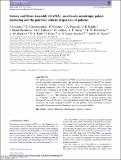Galaxy and Mass Assembly (GAMA) : small-scale anisotropic galaxy clustering and the pairwise velocity dispersion of galaxies
Abstract
The galaxy pairwise velocity dispersion (PVD) can provide important tests of non-standard gravity and galaxy formation models. We describe measurements of the PVD of galaxies in the Galaxy and Mass Assembly (GAMA) survey as a function of projected separation and galaxy luminosity. Due to the faint magnitude limit (r < 19.8) and highly complete spectroscopic sampling of the GAMA survey, we are able to reliably measure the PVD to smaller scales (r⊥ = 0.01 h−1 Mpc) than previous work. The measured PVD at projected separations r⊥ ≲ 1 h−1 Mpc increases near monotonically with increasing luminosity from σ12 ≈ 200 km s−1 at Mr = −17 mag to σ12 ≈ 600 km s − 1 at Mr ≈ −22 mag. Analysis of the Gonzalez-Perez et al. (2014) galform semi-analytic model yields no such trend of PVD with luminosity: the model overpredicts the PVD for faint galaxies. This is most likely a result of the model placing too many low-luminosity galaxies in massive haloes.
Citation
Loveday , J , Christodoulou , L , Norberg , P , Peacock , J A , Baldry , I K , Bland-Hawthorn , J , Brown , M J I , Colless , M , Driver , S P , Holwerda , B W , Hopkins , A M , Kafle , P R , Liske , J , Lopez-Sanchez , A R & Taylor , E N 2017 , ' Galaxy and Mass Assembly (GAMA) : small-scale anisotropic galaxy clustering and the pairwise velocity dispersion of galaxies ' , Monthly Notices of the Royal Astronomical Society , vol. 474 , no. 3 , pp. 3435-3450 . https://doi.org/10.1093/mnras/stx2971
Publication
Monthly Notices of the Royal Astronomical Society
Status
Peer reviewed
ISSN
0035-8711Type
Journal article
Collections
Items in the St Andrews Research Repository are protected by copyright, with all rights reserved, unless otherwise indicated.
Related items
Showing items related by title, author, creator and subject.
-
SDSS-IV MaNGA: How the stellar populations of passive central galaxies depend on stellar and halo mass
Oyarzún, Grecco A.; Bundy, Kevin; Westfall, Kyle B.; Tinker, Jeremy L.; Belfiore, Francesco; Argudo-Fernández, Maria; Zheng, Zheng; Conroy, Charlie; Masters, Karen L.; Wake, David; Law, David R.; McDermid, Richard M.; Aragón-Salamanca, Alfonso; Parikh, Taniya; Yan, Renbin; Bershady, Matthew; Sánchez, Sebastián F.; Andrews, Brett H.; Fernández-Trincado, José G.; Lane, Richard R.; Bizyaev, D.; Boardman, Nicholas Fraser; Lacerna, Ivan; Brownstein, J. R.; Drory, Niv; Zhang, Kai (2022-07-06) - Journal articleWe analyze spatially resolved and co-added SDSS-IV MaNGA spectra with signal-to-noise ratio ∼100 from 2200 passive central galaxies (z ∼ 0.05) to understand how central galaxy assembly depends on stellar mass (M*) and halo ... -
Secular-and merger-built bulges in barred galaxies
Mendez Abreu, Jairo; Debattista, V. P.; Corsini, E. M.; Aguerri, J. A. L. (2014-12) - Journal articleContext. Historically, galaxy bulges were thought to be single-component objects at the center of galaxies. However, this picture is now questioned since different bulge types with different formation paths, namely classical ... -
Galaxy And Mass Assembly (GAMA) : galaxy close pairs, mergers and the future fate of stellar mass
Robotham, A. S. G.; Driver, S. P.; Davies, L. J. M.; Hopkins, A. M.; Baldry, I. K.; Agius, N. K.; Bauer, A. E.; Bland-Hawthorn, J.; Brough, S.; Brown, M. J. I.; Cluver, M.; De Propris, R.; Drinkwater, M. J.; Holwerda, B. W.; Kelvin, L. S.; Lara-Lopez, M. A.; Liske, J.; Lopez-Sanchez, A. R.; Loveday, J.; Mahajan, S.; McNaught-Roberts, T.; Moffett, A.; Norberg, P.; Obreschkow, D.; Owers, M. S.; Penny, S. J.; Pimbblet, K.; Prescott, M.; Taylor, E. N.; van Kampen, E.; Wilkins, S. M. (2014-11-11) - Journal articleWe use a highly complete subset of the Galaxy And Mass Assembly II (GAMA-II) redshift sample to fully describe the stellar mass dependence of close pairs and mergers between 10(8) and 10(12)M(circle dot). Using the analytic ...

